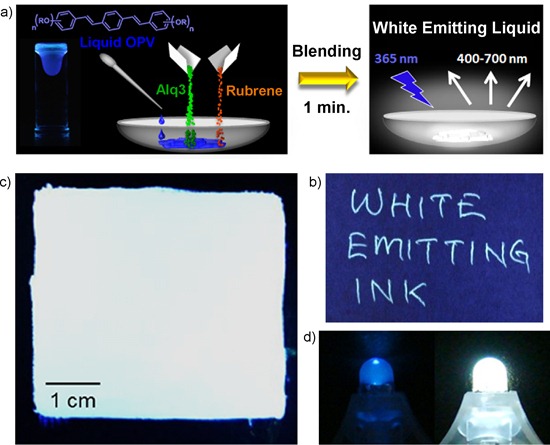
A research team headed by Dr. Takashi Nakanishi, a Principal Researcher of the Organic Materials Group of the NIMS Polymer Materials Unit, developed a nonvolatile liquid material which emits white light at room temperature.
Because lighting devices account for about 20% of all electric power consumption, innovative materials and technological improvements are desired in order to reduce emissions of greenhouse effect gases (GHG).
In particular, high expectations are placed on organic materials which emit white light as a light source material for next-generation lighting, replacing today’s incandescent light bulbs and fluorescent tubes.
Although the organic materials which have been developed to date display a white light-emitting property when dispersed in a solution, the molecules tend to aggregate when the solution is coated on a substrate and the solvent is evaporated.
This problem is the reason why these materials cannot fully demonstrate their intrinsic white-light emitting performance. Furthermore, from the viewpoint of the manufacturing process, an organic material which can be prepared by a simple method, without use of volatile organic solvents, achieving high brightness, homogeneous white light-emission, had been desired.
Dr. Nakanishi’s team developed a liquid material with blue light fluorescence which is nonvolatile, has a melting point of approximately -45°C, and solves the problem of molecule aggregation, by modifing highly flexible branched alkyl chains around the molecule that can emit fluorescence.
This material is a liquid with a room temperature viscosity of approximately 1.0 Pa·s, which is similar to that of lubricating oil, and does not require use of a volatile organic solvent. It displays blue light emission with an absolute fluorescent quantum yield of approximately 50%. A white light-emitting paste material can also be prepared by mixing a small amount of luminescent dyes in solid powder in the liquid.
Various materials which emit high brightness white light even when coated were successfully prepared, including printing of white light-emitting characters, large area coating, white light-emitting lights by coating on a UV-LED surface, and others.
This research achieved the development of materials which emit white light with high quality using only an extremely simple operation, namely, mixing of a small amount of solid dyes in the nonvolatile, blue light-emitting liquid.
This liquid material can be coated on substrate surfaces with various shapes, and thus is expected to enable broad simplification of the manufacturing processes for lighting devices and other products. Because the emitted color can be controlled with a high brightness, and liquids that display full-color light emission can also be prepared easily, this material is expected to become a new light-emitting material for next-generation printable electronics.



